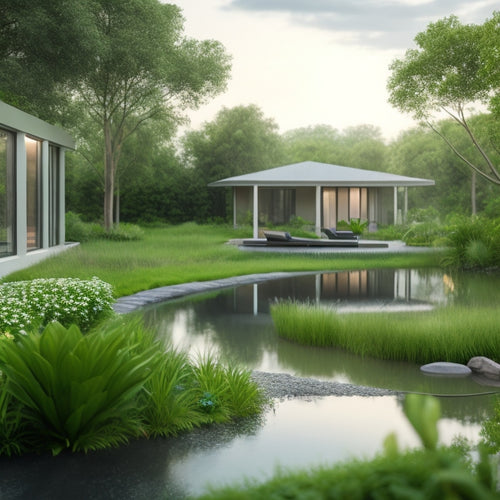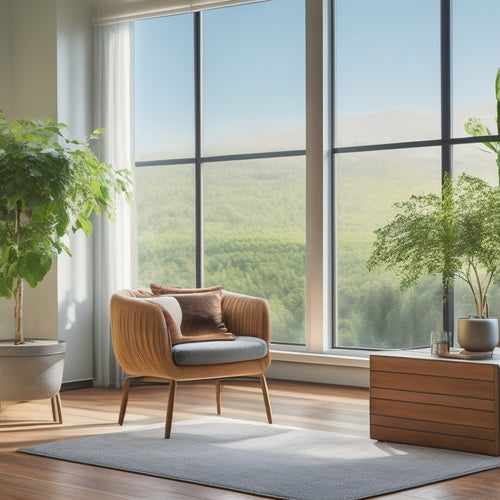
10 Top Windows for Passive Houses: Save Energy
Share
When building a passive house, you need windows that can deliver exceptional thermal performance to minimize heat loss and energy consumption. Top options include triple-glazed windows for ideal insulation, energy-efficient vinyl frames, and low-E glass for minimal heat loss. Passive house certified fiberglass windows, high-performance aluminum frames, and thermally broken frames also make the list. You can further enhance energy efficiency with sustainable wood frames, advanced spacer systems, and gas-filled windows. By choosing the right combination of these features, you can create a comfortable and energy-efficient living space. Now, investigate these options further to find the perfect fit for your project.
Key Takeaways
- Triple-glazed windows with U-values of approximately 0.8 W/m²K provide superior insulation and minimize heat loss for energy savings.
- Energy-efficient vinyl window frames offer thermal breaks, low maintenance, and affordability, making them a popular choice for passive houses.
- Passive House certified fiberglass windows achieve exceptional thermal performance with U-values as low as 0.70 W/m²K for ultimate energy efficiency.
- Advanced spacer systems and thermally broken window frames reduce thermal bridging, minimizing heat transfer and maximizing energy savings in passive houses.
- Low-E glass coatings and gas-filled windows enhance insulation performance, reducing heat loss and overall energy costs in passive house constructions.
Triple-Glazed Windows for Optimal Insulation
When building a passive house, one essential element to contemplate is the type of windows to install.
You'll want to prioritize window selection that maximizes energy savings. Triple-glazed windows are an ideal choice, offering superior insulation and minimizing heat loss.
These windows feature three panes of glass, separated by gas-filled gaps, which greatly reduce heat transfer. As a result, you'll enjoy reduced energy bills and a more comfortable living space.
With triple-glazed windows, you can expect a U-value of around 0.8 W/m²K, making them an excellent option for passive houses.
Energy-Efficient Vinyl Window Frames
In addition to triple-glazed glass, the frames themselves play a critical role in maintaining the energy efficiency of your passive house windows.
When it comes to energy-efficient vinyl window frames, you'll want to take into account frames that offer exceptional vinyl durability and aesthetic appeal.
Vinyl frames can contribute to a sustainable transportation ecosystem by reducing reliance on fossil fuels, similar to wind energy for EV charging. Additionally, they can help minimize greenhouse gas emissions, promoting sustainability in the built environment.
Thermal insulation: Vinyl frames provide a thermal break, reducing heat transfer and minimizing energy loss.
Low maintenance: Vinyl frames are resistant to warping, cracking, and fading, ensuring your windows remain secure and functional.
Cost-effective: Vinyl frames are often more affordable than other materials, making them an attractive option for passive house builders.
Design flexibility: Vinyl frames come in a range of styles and colors, allowing you to customize your windows to suit your design preferences.
Environmental benefits: Vinyl frames are recyclable, reducing waste and minimizing environmental impact.
Low-E Glass for Minimal Heat Loss
You'll find that low-E glass is a critical component in passive house windows, as it considerably reduces heat transfer and minimizes heat loss.
By applying a thin metallic coating to the glass surface, low-E glass reduces the U-value, which measures thermal insulation performance. This coating restricts the flow of heat energy, ensuring that warmth stays in and cold stays out, thereby maintaining a comfortable indoor climate.
Additionally, incorporating solar-powered charging solutions solar hubs can further enhance energy efficiency and reduce reliance on traditional power sources.
Thermal Insulation Performance
By specifying low-E glass, passive house designers can minimize heat loss through windows, thereby reducing the overall heating load. This means you can enjoy a cozy living space while keeping energy costs under control.
Moreover, incorporating renewable energy sources, such as solar energy for EV charging, can also contribute to a sustainable living environment. Additionally, regular maintenance, including cleaning, is crucial for peak energy efficiency in such systems.
When it comes to thermal insulation performance, consider the following benefits:
- Reduced air infiltration guarantees a consistent indoor temperature and minimizes the need for heating.
- Low-E glass helps to maintain a consistent thermal mass, allowing your home to absorb and release heat as needed.
- With minimal heat loss, you'll enjoy a significant reduction in energy consumption.
- This, in turn, leads to a smaller carbon footprint and a more sustainable living environment.
- By reducing the load on your heating system, you'll also prolong its lifespan and reduce maintenance costs.
Reduced Heat Transfer
Low-E glass, a critical component in passive house design, takes center stage in reducing heat transfer. By minimizing heat loss, you can maintain a comfortable indoor temperature while keeping energy bills low.
This advanced glass technology features a thin metallic coating that reflects heat back into the room, rather than allowing it to escape. As a result, you can expect improved thermal performance and energy efficiency, similar to the benefits of renewable energy solutions that reduce fossil fuel reliance and carbon footprint.
In addition, incorporating Low-E glass into your passive house design can lead to significant long-term savings, much like the return on investment (ROI) for renewable energy projects, which ranges from 10-15% annually.
Passive House Certified Fiberglass Windows
Fiberglass windows certified for Passive House construction boast exceptional thermal performance, achieving U-values as low as 0.70 W/m²K. You can trust that these windows will provide unparalleled energy efficiency, keeping your home warm in the winter and cool in the summer.
By integrating renewable energy sources, such as solar power, into your home's design, you can further reduce your reliance on the grid and lower your carbon footprint. Additionally, with the incentives and financial considerations for EV adoption, you can also investigate the possibility of incorporating electric vehicle charging stations into your energy-efficient design.
- Enjoy the freedom to design your dream home, knowing that your windows will support your energy goals
- Experience the durability of fiberglass, which resists warping and cracking even in extreme temperatures
- Benefit from reduced maintenance, as fiberglass windows are resistant to corrosion and decay
- Take advantage of the increased comfort and quiet that comes with superior thermal performance
- Rest assured that your windows are built to last, with a lifespan of 30 years or more
High-Performance Aluminum Window Frames
You've already examined the exceptional thermal performance of Passive House certified fiberglass windows.
Now, let's investigate high-performance aluminum window frames as an alternative. These frames boast exceptional design aesthetics, allowing for sleek, modern profiles that complement any façade.
Furthermore, aluminum's inherent durability guarantees frame longevity, resisting corrosion and wear. Advanced thermal breaks and insulated profiles minimize heat transfer, guaranteeing peak energy efficiency.
Additionally, aluminum's high strength-to-weight ratio enables larger glass surfaces, maximizing natural light and unobstructed views.
Double-Glazed Windows for Cold Climates
When designing double-glazed windows for cold climates, you'll need to take into account the unique challenges posed by freezing temperatures and high winds.
To achieve ideal thermal insulation performance, you must select glazing options that can withstand these harsh conditions.
Cold Climate Considerations
In cold climates, double-glazed windows are essential for maintaining a stable indoor temperature and minimizing heat loss.
You'll need to evaluate the unique challenges of cold climates when designing your passive house.
Effective design strategies for cold climate adaptation include:
- Selecting windows with high insulation values to reduce heat loss
- Orienting windows to maximize solar gain during winter months
- Using window frames with high thermal resistance to prevent heat escape
- Incorporating shading devices to prevent overheating during summer
- Ensuring proper window installation to prevent air leakage and moisture intrusion
Thermal Insulation Performance
Most modern double-glazed windows for cold climates achieve U-values as low as 0.8 W/m²K, greatly reducing heat transfer and minimizing energy losses.
You'll want to look for windows with high thermal resistance ratings to guarantee peak performance.
Different insulation material types, such as fiberglass, foam, or gas-filled spacers, can markedly impact thermal performance.
For example, windows with argon or krypton gas fills can provide up to 30% better thermal insulation than those with air fills.
When selecting windows, consider the R-value, which measures thermal resistance.
Higher R-values indicate better insulation.
Glazing Options Compared
Selecting the right glazing option for your passive house is critical to achieving ideal energy efficiency.
You'll want to weigh the pros and cons of different glazing options to guarantee you're getting the best performance for your climate.
When it comes to double-glazed windows for cold climates, consider the following key factors:
-
Window frame materials: Look for frames made from materials with low thermal conductivity, such as fiberglass or vinyl, to minimize heat loss.
-
Glazing thickness options: Thicker glazing (e.g., 16mm or 20mm) provides better thermal insulation, but may add cost and weight.
-
Low-E coatings: Apply these coatings to reduce heat transfer and minimize energy loss.
-
Gas fillings: Use inert gases like argon or krypton to reduce convection and improve insulation.
-
Spacer systems: Opt for warm-edge spacers to reduce thermal bridging and minimize heat loss.
Thermally Broken Window Frames
By opting for thermally broken window frames, you guarantee that the thermal bridge at the window frame is minimized, thereby reducing heat loss and energy consumption. This is essential in passive houses, where energy efficiency is paramount.
Thermally broken window frames are designed to break the thermal connection between the exterior and interior of the window, ensuring that the cold outside air doesn't seep into your home.
When selecting window frame materials, consider those with high thermal performance factors, such as fiberglass, vinyl, or aluminum with thermal breaks. These materials will help reduce heat transfer, keeping your home warm in the winter and cool in the summer.
Sustainable Wood Window Frames Option
Several sustainable wood window frame options are emerging as a viable alternative to traditional materials, offering a unique blend of eco-friendliness and thermal performance.
You can choose from various eco-friendly materials that not only reduce your carbon footprint but also provide excellent frame durability.
Some of the benefits of sustainable wood window frames include:
- Lower embodied energy compared to traditional materials
- Locally sourced and FSC-certified options available
- Natural insulation properties for improved thermal performance
- Aesthetic appeal with various wood species and finishes
- End-of-life recyclability for minimal waste
Advanced Spacer Systems for Efficiency
In the pursuit of ideal window performance, advanced spacer systems have emerged as an essential component, playing a considerable role in minimizing heat transfer and maximizing energy efficiency.
You'll find that these systems considerably reduce thermal bridging, allowing you to achieve optimal energy savings. Advanced spacer materials, such as fiberglass or foam-based solutions, offer improved thermal insulation compared to traditional metal spacers.
By incorporating these advanced spacer systems into your window design, you can expect to see a notable reduction in heat transfer, resulting in substantial energy savings.
This innovative technology enables you to create highly efficient windows that meet the stringent requirements of passive house design, giving you the freedom to create a sustainable and energy-efficient living space.
Gas-Filled Windows for Added Insulation
You'll find that gas-filled windows can greatly enhance insulation performance, reducing heat transfer and energy losses.
By filling the gap between panes with a noble gas like argon or krypton, you can minimize thermal bridging and optimize the window's overall thermal performance.
When selecting a gas-filled window, you'll need to weigh the benefits of each gas type, considering factors like insulation performance, cost, and environmental impact.
Insulation Performance Boost
While working to minimize heat transfer, passive house designers often turn to gas-filled windows as a means of enhancing insulation performance.
You can markedly enhance the insulation performance of your windows by selecting the right gas fill.
- Argon or krypton fillings reduce heat transfer by minimizing convection
- Insulation materials with low thermal conductivity improve energy efficiency
- Performance testing guarantees the gas fill meets your energy-saving goals
- Gas-filled windows can reduce heat loss by up to 50%
- Proper installation is essential to maintaining the insulation performance of gas-filled windows
Thermal Bridge Reduction
Selecting the right gas fill is just one aspect of optimizing window insulation performance for passive houses.
You'll also need to evaluate thermal bridge reduction strategies to minimize heat loss. A thermal bridge analysis will help you identify areas where heat escapes, allowing you to implement targeted insulation strategies.
In gas-filled windows, the space between the panes can be a significant thermal bridge. By using a gas with low thermal conductivity, such as argon or krypton, you can reduce heat transfer and improve overall window insulation performance.
This, combined with a well-designed frame and proper installation, will help you achieve the high levels of energy efficiency required in passive houses.
Argon Vs Krypton
Insulation performance in gas-filled windows hinges on the choice between argon and krypton, two popular fill gases that offer distinct advantages.
You'll want to evaluate the pros and cons of each to make an informed decision for your passive house windows.
Here are the key differences:
-
Argon benefits: lower cost, suitable for most climate zones, and provides decent insulation performance
-
Krypton efficiency: higher insulation performance, ideal for extreme climate zones, and offers superior soundproofing
-
Argon is more widely available, but krypton's superior insulation properties may be worth the extra cost
-
Krypton-filled windows can be more expensive, but they provide a higher level of energy efficiency
-
Ultimately, your choice between argon and krypton depends on your specific climate, budget, and energy efficiency goals
Frequently Asked Questions
Can Passive House Windows Be Installed in Existing Homes?
You can install passive house windows in existing homes, but you'll face installation challenges, such as ensuring airtight seals and proper insulation, to maintain energy efficiency and optimize performance.
Are Triple-Glazed Windows Worth the Extra Cost?
As you weigh the cost, consider this: triple-glazed windows will slash your energy bills, and the extra upfront expense will pay for itself through long-term cost savings, ultimately giving you the freedom to allocate resources as you see fit.
Do Passive House Windows Require Special Maintenance?
You'll find that passive house windows don't require much special maintenance, but you'll still need to clean them regularly using gentle techniques to preserve their integrity and extend their window lifespan, ensuring ideal performance and freedom from energy woes.
Can I Use Passive House Windows in Warm Climates?
While you might associate passive house windows with cold climates, you can definitely use them in warm climates too, leveraging performance benefits like reduced heat gain and climate considerations to create a comfortable, energy-efficient space that's free from extreme temperatures.
Are Passive House Windows Compatible With Smart Home Systems?
You can seamlessly integrate passive house windows with smart home systems, leveraging smart technology integration to optimize energy efficiency benefits, while maintaining control and flexibility in your living space.
Related Posts
-

How to Upgrade Your Home With Geothermal Innovations
You're now on the cusp of utilizing the Earth's natural thermal energy to revolutionize your home's heating and cooli...
-

7 Best Automated Sprinklers for Water-Wise Green Homes
You're likely among the 75% of U.S. homeowners who use in-ground sprinkler systems, and coincidentally, you're also c...
-

7 Smart Air Purification Hacks for Energy-Savvy Homes
You can notably improve your indoor air quality while minimizing energy consumption by implementing strategic air pur...


